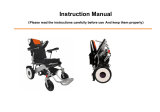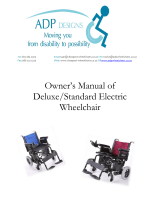
Navix
2015-08
Page 9
1.6 Safety instructions
L
When getting into and out of the wheelchair, do not stand on the footrests. The footplate
should be folded up beforehand.
L Investigate the effects of shifting the centre of gravity on the behavior of the wheelchair,
for example on up or down gradients, on laterally sloping ground, or when overcoming
obstacles. Obtain support from an attendant.
L If you want to pick up something (lying in front of, on the side, or to the rear of the
wheelchair), you should not lean too far out to avoid tipping over.
L When moving through doors, arches, etc. ensure that there is enough room at the sides
so that you do not get your hands or arms caught or crushed and that there is no
damage to the wheelchair.
L Avoid uncontrolled rolling against obstacles (steps, curbs, doorframes, etc) or dropping
down from ledges. The manufacturer cannot assume liability for damage caused by
overloading, collision or other improper use.
L When moving in public places, you are subject to local regulations.
L Influence of medicine or alcohol reduces your driving capabilities.
L When travelling outdoors, adapt your driving to weather and traffic conditions.
L Do not use your electric wheelchair in rainy conditions.
L Do not put your electric wheelchair into the free-wheeling position on slopes.
L Never reverse uphill.
L Reduce speed when you go round corners.
L To be better visible when driving in the dark, wear the brightest possible clothing or
clothes with reflectors and make sure that the reflectors of the wheelchair are clearly
visible and drive with lightning on.
L Make sure that the lights and reflectors of your electric wheelchair are free from dirt
and/or other objects that could hide them.
L When transporting the wheelchair, never pick it up by grasping movable parts (wheels,
seat cushion, etc.)
L When transporting the electric wheelchair, no persons may be transferred along with it.
L No additional passengers may be taken.
L When storing or parking your electric wheelchair outside, protect it with a shrouding
cover against humidity.
L High levels of humidity or very cold conditions can reduce the performance of your
electric wheelchair.
L Never use your electric wheelchair as a seat in an automobile or other vehicle.
L Never exceed the maximum load of 130 kg.
L Use only Vermeiren approved accessories.
L Before getting on or off, taking apart or transporting your electric wheelchair, put your
wheelchair off with "ON/OFF" button.
L Check that the profile depth of the tyres is adequate.
L If your electric wheelchair has pneumatic tyres, be careful to inflate them to the correct
pressure (see pressure indication on the tyres).
L If devices and furnishings like ramps or lifts are available, use them.
L Mount the seat frame during assembly correct on the lower frame for the front wheel and
rear wheel drive wheelchair. Footrests must be on the same side as the thermal fuse on
the battery cover. Otherwise the driving software, program of your wheelchair is not
working correct.






















